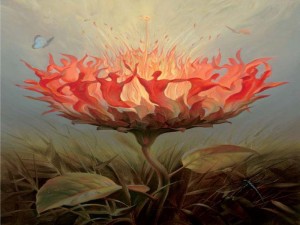The Diamond Sutra (Vajrachchedika Prajnaparamita Sutra) occupies a unique position in the vast literature of the Mahayana. One of the earliest to highlight a doctrinal understanding of the Prajñāpāramitā motifs in Mahayana Literature, an important discovery of an ancient woodblock print of the Sutra back in 1907 within the “caves of the thousand Buddhas” just outside Dunhuang and preserved for centuries within this topographical arid desert, presents a most fascinating and enduring—as well as an endearing—captivation of this ancient artifact. One of my primary resources for the development of this series on the Diamond Sutra is Mu Soeng’s “The Diamond Sutra: transforming the way we perceive the world”, Wisdom Publications, 2000. Soeng’s early description of the paramount significance of this Wisdom-Sutra is indeed grand; I just could not surrender a syllable and it runs thus:
“Among the manuscripts discovered in the Dunhuang caves was a copy of the Diamond Sutra, which was printed from a series of woodblocks, each reproducing an unalterable image of an entire page. The sheets were glued side-to-side and rolled into a scroll sixteen feet long. The title page shows a serene Buddha on a lotus guarded by angels and lions. The colophon says it was completed on the equivalent of May 11, 868 C.E., making it the world’s oldest printed book, dated some seven hundred years before Gutenburg’s invention of the printing press.
Long before the Dunhuang discovery, the Diamond Sutra has been one of the most revered texts of east Asian Buddhism. It is one of the primary texts of the Prajnaparamita literature, which forms the earliest layer of the emerging Mahayana tradition in India, beginning around 100 B.C.E. Although the most commonly accepted date for the Diamond Sutra is around 350 C.E., it is possible that it is even older. Hajime Nakamura contends that the Diamond Sutra (and the Heart Sutra) should be dated to around 150 and 200 C.E.
A relatively short text, the Diamond sutra consists of thrity-two short chapters presenting a dialog between the Buddha and his disciple Subhuti, centered primarily on the twin themes of emptiness and the path of the bodhisattva. It enumerates the six perfections of the bodhisattva path but focuses on the perfection of wisdom.
Through the discussion of these two themes, the Diamond Sutra occupies a leading position in both a historical sense (the emergence of early Mahayana in the form of Bodhisattvayana) and a doctrinal sense (shunyata as the central themse of the Prajnaparamita sutras, of which the Diamond Sutra is an independent part…” [The Diamond Suta, transforming the way we perceive the world, Mu Soeng, pg. 58-59].
This video highlights the mysticality wherein this Sutra first took root:


Definitely my favourite sutra
(Tremendously beautiful melody, too.)
Agreed–that melody is from the best of Kitaro, his Dunhuang-Silk Road creative period, circa the mid-80’s.